
|
Now it is 9.1 mag (Apr. 9, Marco Goiato). Fading slowly. In the Northern Hemisphere, it is not observable now, but it will appear in August. It locates somewhat low in the Southern Hemisphere. But it will become high in summer.
Date(TT) R.A. (2000) Decl. Delta r Elong. m1 Best Time(A, h)
Apr. 29 4 37.57 -26 15.8 2.908 2.422 52 9.2 20:16 ( 69,-16)
May 6 4 48.75 -23 43.7 3.012 2.478 49 9.4 20:24 ( 74,-19)
|

|
Now it is 10.6 mag (Apr. 9, Ken-ichi Kadota). It stays 10 mag for a while. Now it is not observable. It will appear in June.
Date(TT) R.A. (2000) Decl. Delta r Elong. m1 Best Time(A, h)
Apr. 29 2 32.49 26 37.2 3.202 2.231 12 10.0 20:16 (131, -8)
May 6 2 37.71 25 25.1 3.217 2.228 9 10.0 3:30 (229, -9)
|
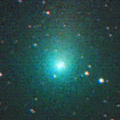
|
Now it is 10.6 mag (Apr. 27, Osamu Miyazaki). Fading gradually. In the Northern Hemisphere, it will be getting higher gradually. In the Southern Hemisphere, it is not observable now, but it will appear in May.
Date(TT) R.A. (2000) Decl. Delta r Elong. m1 Best Time(A, h)
Apr. 29 0 29.29 39 52.0 2.682 1.955 35 11.4 3:39 (233, 18)
May 6 0 36.54 39 7.2 2.710 1.997 36 11.6 3:30 (235, 19)
|

|
Now it is 12.1 mag (Apr. 27, Osamu Miyazaki). Fading slowly. It will be getting lower gradually after this, and it will be unobservable in July in the Northern Hemisphere, or in August in the Southern Hemisphere.
Date(TT) R.A. (2000) Decl. Delta r Elong. m1 Best Time(A, h)
Apr. 29 10 58.96 -2 51.6 2.922 3.634 128 11.6 20:30 ( 0, 52)
May 6 10 49.55 -3 13.2 3.034 3.640 119 11.6 20:24 ( 12, 51)
|

|
Now it is 11.9 mag (Apr. 12, Michael Jager). It will fade out rapidly after this. It will be fainter than 18 mag in July. In the Northern Hemisphere, it will be unobservable in May. But it will be observable again in June. In the Southern Hemisphere, it will be getting higher gradually.
Date(TT) R.A. (2000) Decl. Delta r Elong. m1 Best Time(A, h)
Apr. 29 23 38.17 -6 20.1 0.277 0.838 45 11.6 3:39 (279, 2)
May 6 0 5.78 -8 30.1 0.356 0.812 47 11.7 3:30 (279, -1)
|

|
It approached to Earth down to 0.29 a.u. in early February, and it brightened up to 4.5 mag (Feb. 1, Juan Jose Gonzalez). Now it is 11.6 mag (Apr. 23, Jose Guilherme de S. Aguiar). Fading gradually. It stays extremely low in the Northern Hemisphere. It locates somewhat low in the Southern Hemisphere. But it will become high in summer.
Date(TT) R.A. (2000) Decl. Delta r Elong. m1 Best Time(A, h)
Apr. 29 5 12.92 -11 17.2 2.471 1.967 49 11.9 20:16 ( 76, 0)
May 6 5 18.58 -12 8.0 2.607 2.048 46 12.2 20:24 ( 80, -7)
|

|
Now it is 12.2 mag (Apr. 30, Marco Goiato). It stays 13 mag for a while. In the Northern Hemisphere, it is not observable now. In the Southern Hemisphere, it stays observable in good condition. It was expected to brighten up to 10 mag from spring to summer. However, it is fainter than originally expected.
Date(TT) R.A. (2000) Decl. Delta r Elong. m1 Best Time(A, h)
Apr. 29 20 39.86 -55 27.0 2.747 3.075 99 12.3 3:39 (339, -6)
May 6 20 47.00 -58 48.3 2.665 3.073 104 12.3 3:30 (342, -8)
|

|
It is expected to brighten up to 8 mag in July. Now it is 14.9 mag (Apr. 19, B. Lutkenhoner, N. Paul, E. Cortes). It will brighten rapidly after this. In the Northern Hemisphere, it is not observable now, but it will appear in June. In the Southern Hemisphere, it will be getting higher gradually. At the high light, it will be observable in excellent condition in the Southern Hemisphere, but it will be very low in the Northern Hemisphere.
Date(TT) R.A. (2000) Decl. Delta r Elong. m1 Best Time(A, h)
Apr. 29 0 39.52 -10 53.8 2.688 1.963 35 12.6 3:39 (274,-13)
May 6 0 41.30 -11 8.6 2.530 1.904 41 12.3 3:30 (276,-10)
|

|
Now it is 13.3 mag (Apr. 24, Osamu Miyazaki). Fading gradually. It stays observable in good condition.
Date(TT) R.A. (2000) Decl. Delta r Elong. m1 Best Time(A, h)
Apr. 29 17 51.62 -18 26.0 1.250 2.047 129 12.6 3:27 ( 0, 37)
May 6 17 49.79 -18 20.5 1.231 2.086 137 12.6 2:57 ( 0, 37)
|
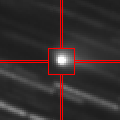
|
It brightened very rapidly as expected. Now it is 12.7 mag (Apr. 24, Ken-ichi Kadota). Fading slowly. It stays observable in good condition.
Date(TT) R.A. (2000) Decl. Delta r Elong. m1 Best Time(A, h)
Apr. 29 19 34.26 -15 35.1 1.473 1.991 105 12.8 3:39 (333, 35)
May 6 19 42.32 -14 0.4 1.406 1.988 109 12.7 3:30 (335, 37)
|

|
It brightened up to 8.3 mag in last winter (Jan. 6, 2022, Toshiyuki Takahashi). Now it is 12.8 mag (Apr. 23, Jose Guilherme de S. Aguiar). Fading slowly. In the Northern Hemisphere, it will be unobservable in June. In the Southern Hemisphere, it stays observable in good condition.
Date(TT) R.A. (2000) Decl. Delta r Elong. m1 Best Time(A, h)
Apr. 29 9 3.03 -31 45.3 5.095 5.456 105 12.7 20:16 ( 22, 19)
May 6 9 4.65 -31 19.7 5.209 5.499 101 12.8 20:24 ( 30, 16)
|
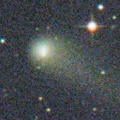
|
It brightened up to 11.1 mag in early 2022 (Mar. 31, 2022, F. Kugel, J.-G. Bosch, J. Nicolas). Now it is 13.1 mag (Apr. 27, Osamu Miyazaki). Fading slowly. It stays observable in good condition.
Date(TT) R.A. (2000) Decl. Delta r Elong. m1 Best Time(A, h)
Apr. 29 15 35.09 17 48.5 4.162 5.006 143 13.1 1:10 ( 0, 73)
May 6 15 32.04 18 47.1 4.190 5.036 143 13.2 0:40 ( 0, 74)
|
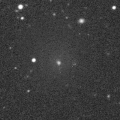
|
It has large but very diffuse coma. It seems to brighten up to 10.5 mag in July. Now it is 12.9 mag (Apr. 21, Thomas Lehmann). Brightening rapidly. In the Northern Hemisphere, it stays observable in good condition. In the Southern Hemisphere, it will be unobservable in May. But it will be observable again in August.
Date(TT) R.A. (2000) Decl. Delta r Elong. m1 Best Time(A, h)
Apr. 29 12 17.82 53 3.5 0.766 1.437 107 13.7 21:49 (180, 72)
May 6 12 13.14 57 12.2 0.767 1.365 99 13.3 21:17 (180, 68)
|

|
Rob Matson discovered it as a new comet from SWAN images between Apr. 5 and 15. It was revealed to be an asteroid which has been observed also in 2012 and 2018. It approached to Sun down to 0.5 a.u. on Mar. 29. Now it is 13.6 mag (Apr. 20, Michael Jager). It will fade out rapidly after this. It will be fainter than 18 mag in July. In the Northern Hemisphere, it is not observable now, but it will appear in June. In the Southern Hemisphere, it will be getting higher gradually.
Date(TT) R.A. (2000) Decl. Delta r Elong. m1 Best Time(A, h)
Apr. 29 3 15.96 -36 15.7 0.459 0.810 52 13.4 20:16 ( 67,-36)
May 6 3 15.70 -47 58.3 0.421 0.911 64 13.7 20:24 ( 53,-45)
|
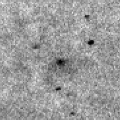
|
Now it is 13.0 mag (Apr. 25, Jose Guilherme de S. Aguiar). Fading slowly. It locates somewhat low in the Northern Hemisphere. But it will become high in summer. In the Southern Hemisphere, it stays observable in good condition.
Date(TT) R.A. (2000) Decl. Delta r Elong. m1 Best Time(A, h)
Apr. 29 23 23.26 -12 7.1 2.269 1.825 51 13.6 3:39 (286, 1)
May 6 23 37.96 -10 49.8 2.248 1.857 54 13.7 3:30 (285, 3)
|

|
Now it is 13.7 mag (Apr. 19, W. Pei). It stays 14 mag for a while. It will be unobservable in June. But it will be observable again in August in the Northern Hemisphere.
Date(TT) R.A. (2000) Decl. Delta r Elong. m1 Best Time(A, h)
Apr. 29 6 35.31 27 5.6 6.538 6.094 59 14.0 20:16 (100, 37)
May 6 6 39.63 26 54.8 6.634 6.096 54 14.0 20:24 (103, 31)
|
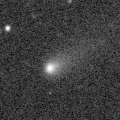
|
Now it is 14.3 mag (Apr. 21, Catalina Sky Survey). Fading gradually. It locates somewhat low in the Northern Hemisphere. In the Southern Hemisphere, it stays observable in good condition.
Date(TT) R.A. (2000) Decl. Delta r Elong. m1 Best Time(A, h)
Apr. 29 13 54.67 -30 16.1 1.375 2.355 162 14.0 23:26 ( 0, 25)
May 6 13 46.15 -30 57.5 1.388 2.359 159 14.0 22:50 ( 0, 24)
|
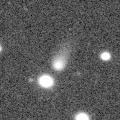
|
It is expected to brighten up to 7 mag in early 2024. Now it is 14.1 mag (Apr. 19, ATLAS South Africa). Brightening gradually. In the Northern Hemisphere, it is not observable now. In the Southern Hemisphere, it will be getting lower gradually. But it will be getting higher again after July.
Date(TT) R.A. (2000) Decl. Delta r Elong. m1 Best Time(A, h)
Apr. 29 5 41.52 -26 33.8 4.290 3.939 63 14.1 20:16 ( 60, -4)
May 6 5 48.22 -25 53.0 4.264 3.869 60 14.0 20:24 ( 65, -9)
|

|
The brightness evolution is slower than originally predicted. Now it is 14.7 mag (Apr. 9, ATLAS Chile). It stays 14 mag for a while. In the Northern Hemisphere, it is not observable now. It locates somewhat low in the Southern Hemisphere. But it will become high in winter.
Date(TT) R.A. (2000) Decl. Delta r Elong. m1 Best Time(A, h)
Apr. 29 4 39.66 -23 59.2 2.515 2.033 50 14.0 20:16 ( 70,-14)
May 6 4 52.91 -25 10.7 2.508 2.033 51 14.0 20:24 ( 72,-19)
|
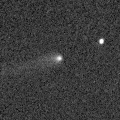
|
Now it is 14.9 mag (Mar. 19, Masayoshi Yoshimi). It stays 14 mag for a while. Now it is not observable. It will appear in May in the Southern Hemisphere, or in June in the Northern Hemisphere.
Date(TT) R.A. (2000) Decl. Delta r Elong. m1 Best Time(A, h)
Apr. 29 2 37.70 -0 41.1 4.205 3.245 15 14.7 20:16 (109,-26)
May 6 2 38.96 0 10.6 4.195 3.240 16 14.7 3:30 (249,-27)
|

|
It will brighten rapidly up to 13.5 mag in summer. Now it is 17.1 mag (Apr. 8, B. Lutkenhoner, N. Paul, E. Cortes). Brightening slowly. In the Northern Hemisphere, it is not observable now, but it will appear in June.
Date(TT) R.A. (2000) Decl. Delta r Elong. m1 Best Time(A, h)
Apr. 29 0 10.55 -22 6.8 2.364 1.860 48 15.1 3:39 (288,-14)
May 6 0 23.19 -19 13.2 2.298 1.832 50 15.0 3:30 (286,-11)
|
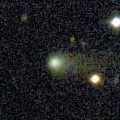
|
Now it is 14.8 mag (Apr. 19, W. Pei). Fading slowly. In the Northern Hemisphere, it stays observable in good condition. In the Southern Hemisphere, it will be unobservable in August.
Date(TT) R.A. (2000) Decl. Delta r Elong. m1 Best Time(A, h)
Apr. 29 9 37.52 28 49.5 3.149 3.449 98 15.1 20:16 ( 70, 75)
May 6 9 43.03 28 26.9 3.253 3.464 93 15.1 20:24 ( 78, 69)
|
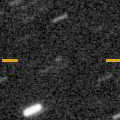
|
Now it is 16.8 mag (Apr. 19, ATLAS South Africa). It stays 15 mag for a while. It stays observable in good condition.
Date(TT) R.A. (2000) Decl. Delta r Elong. m1 Best Time(A, h)
Apr. 29 18 34.09 -16 41.9 2.368 2.997 119 15.3 3:39 (351, 38)
May 6 18 35.50 -17 19.5 2.277 2.986 126 15.2 3:30 (356, 38)
|
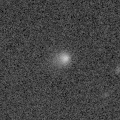
|
Now it is 15.2 mag (Apr. 19, Chris Wyatt). It stays 15 mag for a while. It will be getting lower gradually after this, and it will be unobservable in June in the Northern Hemisphere, or in July in the Southern Hemisphere. It is expected to brighten up to 12 mag from 2024 to 2025.
Date(TT) R.A. (2000) Decl. Delta r Elong. m1 Best Time(A, h)
Apr. 29 8 57.64 -5 24.6 5.412 5.670 99 15.3 20:16 ( 37, 42)
May 6 8 56.04 -4 23.3 5.488 5.627 92 15.3 20:24 ( 48, 38)
|
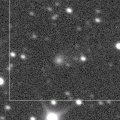
|
It will brighten up to 14 mag from 2024 to 2025. Now it is 15.2 mag (Apr. 17, Ken-ichi Kadota). It stays 15 mag for a while. In the Northern Hemisphere, it will be unobservable in June. In the Southern Hemisphere, it stays observable in good condition.
Date(TT) R.A. (2000) Decl. Delta r Elong. m1 Best Time(A, h)
Apr. 29 8 48.08 -32 16.4 5.946 6.246 102 15.3 20:16 ( 25, 17)
May 6 8 50.61 -31 30.2 5.984 6.215 98 15.3 20:24 ( 32, 15)
|

|
Now it is 15.9 mag (Apr. 16, ATLAS Chile). It stays 15 mag for a while. It stays observable in good condition. It is expected to brighten up to 12.5 mag in 2024 spring. At the high light, it will be observable in excellent condition in the Southern Hemisphere, but it will be low in the Northern Hemisphere.
Date(TT) R.A. (2000) Decl. Delta r Elong. m1 Best Time(A, h)
Apr. 29 18 12.84 21 20.4 3.669 4.172 113 15.5 3:39 (352, 76)
May 6 18 4.41 21 57.9 3.540 4.122 118 15.4 3:12 ( 0, 77)
|

|
It brightened up to 13.4 mag in last summer (July 7, Giuseppe Pappa). Now it is 15.2 mag (Apr. 19, J. Jahn, D. Husar, W. Pasche). Fading slowly. In the Northern Hemisphere, it stays observable in good condition. It locates somewhat low in the Southern Hemisphere.
Date(TT) R.A. (2000) Decl. Delta r Elong. m1 Best Time(A, h)
Apr. 29 17 35.58 21 57.3 3.071 3.686 120 15.4 3:11 ( 0, 77)
May 6 17 25.69 24 23.2 3.063 3.726 124 15.4 2:33 ( 0, 79)
|

|
Now it is 16.4 mag (Apr. 28, B. Lutkenhoner, N. Paul, E. Cortes). It stays 15 mag for a while. In the Northern Hemisphere, it is not observable now, but it will appear in May. In the Southern Hemisphere, it will be getting higher gradually.
Date(TT) R.A. (2000) Decl. Delta r Elong. m1 Best Time(A, h)
Apr. 29 23 42.11 -9 49.2 3.966 3.355 46 15.5 3:39 (281, -1)
May 6 23 50.16 -9 4.3 3.908 3.368 51 15.5 3:30 (282, 1)
|

|
It will brighten up to 13 mag in summer. Now it is 16.3 mag (Apr. 9, Ken-ichi Kadota). Brightening gradually. In the Northern Hemisphere, it will be getting higher gradually. In the Southern Hemisphere, it is not observable now, but it will appear in August.
Date(TT) R.A. (2000) Decl. Delta r Elong. m1 Best Time(A, h)
Apr. 29 2 9.00 63 42.8 2.061 1.603 49 15.6 3:39 (203, 19)
May 6 2 6.76 63 20.0 2.048 1.557 47 15.5 3:30 (205, 21)
|

|
Brightened rapidly. Now it is 15.0 mag (Apr. 17, Ken-ichi Kadota). It will fade out rapidly after this. It will be fainter than 18 mag in July. It stays observable in good condition.
Date(TT) R.A. (2000) Decl. Delta r Elong. m1 Best Time(A, h)
Apr. 29 12 24.91 -23 2.1 0.912 1.857 150 15.5 21:57 ( 0, 32)
May 6 12 32.53 -17 52.3 0.961 1.890 147 15.7 21:37 ( 0, 37)
|
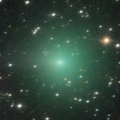
|
It brightened up to 9.7 mag in autumn (Oct. 23, Marco Goiato). Now it is 16.6 mag (Apr. 17, iTelescope Observatory, Siding Spring). It will fade out rapidly after this. It will be fainter than 18 mag in June. It locates somewhat low in the Northern Hemisphere. In the Southern Hemisphere, it stays observable in good condition.
Date(TT) R.A. (2000) Decl. Delta r Elong. m1 Best Time(A, h)
Apr. 29 16 20.24 -44 16.7 1.596 2.461 140 15.7 1:57 ( 0, 11)
May 6 15 42.83 -42 18.4 1.589 2.522 151 16.1 0:53 ( 0, 13)
|

|
It has not been observed yet in this apparition. It will brighten up to 11 mag in July. Brightening rapidly. It stays extremely low in the Northern Hemisphere. But it will become high in autumn. It locates somewhat low in the Southern Hemisphere.
Date(TT) R.A. (2000) Decl. Delta r Elong. m1 Best Time(A, h)
Apr. 29 23 7.76 5 38.9 1.843 1.401 48 16.4 3:39 (274, 15)
May 6 23 32.53 8 1.9 1.764 1.336 48 15.8 3:30 (271, 15)
|
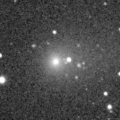
|
It brightened up to 12.4 mag in winter (Feb. 10, Taras Prystavski). Now it is 14.8 mag (Apr. 19, W. Pei). It will fade out rapidly after this. It will be fainter than 18 mag in July. In the Northern Hemisphere, it will be getting lower gradually. In the Southern Hemisphere, it stays observable in good condition.
Date(TT) R.A. (2000) Decl. Delta r Elong. m1 Best Time(A, h)
Apr. 29 9 14.78 20 13.2 1.874 2.231 96 15.8 20:16 ( 58, 66)
May 6 9 24.62 19 44.4 1.982 2.261 92 16.1 20:24 ( 66, 61)
|
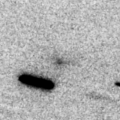
|
Now it is 15.0 mag (Apr. 11, B. Lutkenhoner, N. Paul, E. Cortes). It will fade out rapidly after this. It will be fainter than 18 mag in May. In the Northern Hemisphere, it will never be observable after this. It stays extremely low in the Southern Hemisphere.
Date(TT) R.A. (2000) Decl. Delta r Elong. m1 Best Time(A, h)
Apr. 29 0 58.76 3 15.8 1.704 0.877 23 15.9 3:39 (260, -9)
May 6 1 28.10 6 5.6 1.764 0.917 22 16.4 3:30 (256,-10)
|

|
Now it is 16.5 mag (Apr. 10, Michael Jager). It stays 16 mag for a while. In the Northern Hemisphere, it will be getting lower gradually after this, and it will be unobservable in June. In the Southern Hemisphere, it stays observable in good condition.
Date(TT) R.A. (2000) Decl. Delta r Elong. m1 Best Time(A, h)
Apr. 29 8 20.29 -8 39.3 3.788 3.944 91 16.4 20:16 ( 45, 35)
May 6 8 19.19 -9 0.5 3.875 3.923 85 16.4 20:24 ( 53, 29)
|

|
It continued brightening even after the perihelion passage. Now it is 16.9 mag (Apr. 20, Ken-ichi Kadota). Fading slowly. It will be fainter than 18 mag in July. In the Northern Hemisphere, it will be getting lower gradually after this, and it will be unobservable in July. It locates somewhat low in the Southern Hemisphere.
Date(TT) R.A. (2000) Decl. Delta r Elong. m1 Best Time(A, h)
Apr. 29 8 8.32 24 30.1 2.880 2.897 80 16.4 20:16 ( 83, 55)
May 6 8 16.69 24 5.8 2.996 2.922 76 16.6 20:24 ( 87, 49)
|
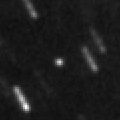
|
It will approach to Sun down to 0.4 a.u. in late September in 2024, and it is expected to brighten up to 0 mag. Now it is 16.4 mag (Apr. 20, Yukihiro Sugiyama). It stays 16 mag for a while. It stays observable in good condition. At the high light, in the Northern Hemisphere, it will be observable in good condition after the perihelion passage. In the Southern Hemisphere, it will be observable in the low sky before and after the perihelion passage.
Date(TT) R.A. (2000) Decl. Delta r Elong. m1 Best Time(A, h)
Apr. 29 14 52.97 2 4.9 5.762 6.727 162 16.6 0:29 ( 0, 57)
May 6 14 47.84 2 24.8 5.700 6.663 161 16.5 23:51 ( 0, 57)
|

|
Now it is 17.2 mag (Apr. 7, ATLAS-HKO, Haleakala). Fading slowly. It will be fainter than 18 mag in August. In the Northern Hemisphere, it will be getting lower gradually. In the Southern Hemisphere, it stays observable in good condition.
Date(TT) R.A. (2000) Decl. Delta r Elong. m1 Best Time(A, h)
Apr. 29 8 52.17 24 47.4 1.984 2.232 90 16.7 20:16 ( 74, 64)
May 6 9 1.96 23 53.6 2.057 2.230 86 16.8 20:24 ( 78, 58)
|

|
Very far object. Now it is 16.9 mag (Apr. 17, ATLAS South Africa). It stays 17 mag for a while. In the Northern Hemisphere, it is not observable now. In the Southern Hemisphere, it stays observable in good condition.
Date(TT) R.A. (2000) Decl. Delta r Elong. m1 Best Time(A, h)
Apr. 29 5 0.67 -68 32.5 10.365 10.369 87 16.8 20:16 ( 25,-31)
May 6 5 3.27 -68 8.9 10.354 10.365 87 16.8 20:24 ( 27,-34)
|

|
It brightened up to 9.6 mag in late January (Jan. 25, Toshihiko Ikemura, Hirohisa Sato). Now it is 14.5 mag (Apr. 12, Thomas Lehmann). Fading rapidly. It will be fainter than 18 mag in May. It locates somewhat low in the Northern Hemisphere. In the Southern Hemisphere, it stays observable in good condition.
Date(TT) R.A. (2000) Decl. Delta r Elong. m1 Best Time(A, h)
Apr. 29 7 38.64 -8 45.6 1.875 1.994 81 16.9 20:16 ( 54, 28)
May 6 7 49.75 -10 4.8 2.008 2.063 78 17.4 20:24 ( 58, 23)
|

|
Now it is 17.0 mag (Apr. 15, J. Linder). It stays 17 mag for a while. In the Northern Hemisphere, it stays observable in good condition. In the Southern Hemisphere, it is not observable now, but it will appear in May.
Date(TT) R.A. (2000) Decl. Delta r Elong. m1 Best Time(A, h)
Apr. 29 13 1.61 56 25.5 2.602 3.057 107 16.9 22:33 (180, 69)
May 6 13 0.13 56 16.9 2.632 3.036 103 16.9 22:04 (180, 69)
|
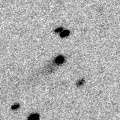
|
Now it is 17.0 mag (Apr. 11, Michael Jager). It stays 17 mag for a while. It stays observable in good condition.
Date(TT) R.A. (2000) Decl. Delta r Elong. m1 Best Time(A, h)
Apr. 29 12 40.82 13 12.9 8.152 8.974 142 16.9 22:12 ( 0, 68)
May 6 12 36.71 13 33.3 8.233 8.981 135 16.9 21:41 ( 0, 68)
|
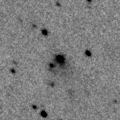
|
It approached to Sun down to 0.1 a.u. on Jan. 31. It was bright as 7.0-7.5 mag in early February (Feb. 5, Michael Jager). Now it is 16.0 mag (Apr. 24, Ken-ichi Kadota). It will fade out rapidly after this. It will be fainter than 18 mag in June. It stays observable in good condition.
Date(TT) R.A. (2000) Decl. Delta r Elong. m1 Best Time(A, h)
Apr. 29 20 4.67 -10 27.2 1.497 1.902 96 16.9 3:39 (322, 36)
May 6 19 55.90 -11 13.4 1.470 1.998 105 17.1 3:30 (330, 39)
|

|
It brightened up to 13.6 mag in 2021 (June 17, 2021, R. Carstens). Now it is 17.2 mag (Apr. 17, ATLAS South Africa). It stays 17 mag for a while. In the Northern Hemisphere, it will never be observable after this. In the Southern Hemisphere, it stays observable in good condition.
Date(TT) R.A. (2000) Decl. Delta r Elong. m1 Best Time(A, h)
Apr. 29 12 13.82 -72 55.3 5.904 6.443 118 16.9 21:44 ( 0,-18)
May 6 11 55.75 -72 8.5 5.930 6.475 118 17.0 20:59 ( 0,-17)
|

|
It brightened up to 9.3 mag in early summer in 2022 (June 5, Chris Wyatt). Now it is 16.8 mag (Apr. 17, Masayoshi Yoshimi). Fading slowly. It will be fainter than 18 mag in June. In the Northern Hemisphere, it will be unobservable in May. In the Southern Hemisphere, it will be getting lower gradually.
Date(TT) R.A. (2000) Decl. Delta r Elong. m1 Best Time(A, h)
Apr. 29 6 48.12 -5 40.9 4.372 4.114 68 17.0 20:16 ( 66, 21)
May 6 6 51.17 -4 29.2 4.535 4.177 63 17.2 20:24 ( 73, 16)
|

|
It brightened up to 12.7 mag in last year (Feb. 27, 2022, Jose Guilherme de S. Aguiar). Now it is 17.2 mag (Apr. 11, ATLAS South Africa). Fading slowly. It will be fainter than 18 mag in August. It locates somewhat low in the Northern Hemisphere. In the Southern Hemisphere, it stays observable in good condition.
Date(TT) R.A. (2000) Decl. Delta r Elong. m1 Best Time(A, h)
Apr. 29 20 1.54 -24 35.7 2.522 2.883 100 17.0 3:39 (331, 24)
May 6 20 4.94 -24 36.5 2.454 2.908 106 17.0 3:30 (334, 26)
|

|
The ATLAS search program detected its cometary activity in this April. Now it is 17.3 mag (Apr. 24, ATLAS Chile). It stays 17 mag for a while. It locates somewhat low in the Northern Hemisphere. In the Southern Hemisphere, it stays observable in good condition.
Date(TT) R.A. (2000) Decl. Delta r Elong. m1 Best Time(A, h)
Apr. 29 22 20.88 -26 2.6 2.835 2.687 71 17.1 3:39 (306, 4)
May 6 22 33.09 -25 36.2 2.763 2.688 75 17.1 3:30 (306, 5)
|
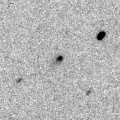
|
Now it is 17.3 mag (Apr. 17, Masayoshi Yoshimi). It stays 18 mag for a while. In the Northern Hemisphere, it stays observable in good condition. It locates somewhat low in the Southern Hemisphere.
Date(TT) R.A. (2000) Decl. Delta r Elong. m1 Best Time(A, h)
Apr. 29 9 26.83 34 18.2 2.258 2.546 94 17.2 20:16 ( 92, 74)
May 6 9 33.83 33 17.7 2.330 2.538 89 17.2 20:24 ( 93, 68)
|
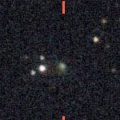
|
It brightened rapidly up to 15.8 mag (Mar. 19, Toshihiko Ikemura, Hirohisa Sato). Now it is 16.4 mag (Apr. 10, Michael Jager). It will fade out rapidly after this. It will be fainter than 18 mag in May. In the Northern Hemisphere, it will be getting lower gradually. It locates somewhat low in the Southern Hemisphere.
Date(TT) R.A. (2000) Decl. Delta r Elong. m1 Best Time(A, h)
Apr. 29 7 18.56 20 31.5 1.995 1.907 70 17.2 20:16 ( 86, 43)
May 6 7 21.90 17 14.6 2.134 1.933 64 17.4 20:24 ( 87, 35)
|

|
It returns for the first time in 70 years. It will brighten up to 4.5 mag in 2024 spring. Now it is 17.9 mag (Apr. 3, Ken-ichi Kadota). Brightening gradually. In the Northern Hemisphere, it stays observable in good condition. In the Southern Hemisphere, it will be unobservable in July.
Date(TT) R.A. (2000) Decl. Delta r Elong. m1 Best Time(A, h)
Apr. 29 19 36.54 41 46.1 4.603 4.694 88 17.4 3:39 (242, 71)
May 6 19 36.11 43 24.7 4.489 4.628 91 17.2 3:30 (234, 74)
|
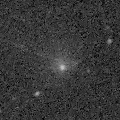
|
Very large comet. It is expected to brighten up to 14 mag in 2031. Now it is 16.7 mag (Apr. 14, Thomas Lehmann). It stays 17 mag for a while. In the Northern Hemisphere, it is not observable now. In the Southern Hemisphere, it will be getting higher gradually. In the Northern Hemisphere, it is not observable until 2030.
Date(TT) R.A. (2000) Decl. Delta r Elong. m1 Best Time(A, h)
Apr. 29 2 53.74 -57 15.4 18.015 17.726 71 17.3 20:16 ( 41,-43)
May 6 2 56.88 -57 16.0 17.959 17.700 73 17.3 20:24 ( 41,-48)
|
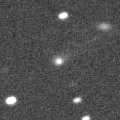
|
It brightened up to 15.9 mag in 2022 spring (May 5, Toshiyuki Takahashi). Now it is 17.2 mag (Apr. 17, ATLAS South Africa). It stays 18 mag for a while. It stays observable in good condition.
Date(TT) R.A. (2000) Decl. Delta r Elong. m1 Best Time(A, h)
Apr. 29 16 25.13 -24 41.8 4.023 4.917 149 17.6 2:01 ( 0, 30)
May 6 16 22.08 -24 40.3 3.981 4.924 156 17.5 1:30 ( 0, 30)
|

|
It stays 17 mag for a while. In the Northern Hemisphere, it will be getting higher gradually. In the Southern Hemisphere, it stays observable in good condition.
Date(TT) R.A. (2000) Decl. Delta r Elong. m1 Best Time(A, h)
Apr. 29 22 13.61 -9 37.1 3.317 3.054 66 17.6 3:39 (295, 16)
May 6 22 21.87 -9 12.6 3.226 3.050 71 17.6 3:30 (296, 18)
|
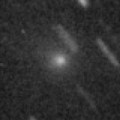
|
It brightened up to 11 mag in SWAN images in January (Jan. 23, Vladimir Bezugly). Now it is 16.3 mag (Apr. 1, iTelescope Observatory, Siding Spring). Fading rapidly. It will be fainter than 18 mag in May. In the Northern Hemisphere, it will never be observable after this. In the Southern Hemisphere, it stays observable in good condition.
Date(TT) R.A. (2000) Decl. Delta r Elong. m1 Best Time(A, h)
Apr. 29 0 24.92 -63 40.1 1.730 1.862 81 17.6 3:39 (328,-33)
May 6 1 15.21 -66 16.9 1.769 1.950 84 18.0 3:30 (330,-37)
|

|
Now it is 17.3 mag (Apr. 18, ATLAS-HKO, Haleakala). It stays 18 mag for a while. In the Northern Hemisphere, it stays observable in good condition. In the Southern Hemisphere, it will never be observable after this.
Date(TT) R.A. (2000) Decl. Delta r Elong. m1 Best Time(A, h)
Apr. 29 18 8.11 77 34.4 9.970 9.896 82 17.6 3:39 (180, 47)
May 6 17 56.74 78 20.1 10.007 9.914 81 17.6 3:02 (180, 47)
|
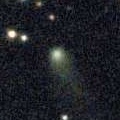
|
Now it is 17.9 mag (Apr. 8, Mt. Lemmon Survey). It stays 18 mag for a while. In the Northern Hemisphere, it stays observable in good condition. In the Southern Hemisphere, it will never be observable after this.
Date(TT) R.A. (2000) Decl. Delta r Elong. m1 Best Time(A, h)
Apr. 29 18 54.23 59 11.8 6.398 6.454 88 17.6 3:39 (195, 65)
May 6 18 53.62 60 17.1 6.423 6.489 89 17.7 3:30 (189, 64)
|

|
It brightened very rapidly up to 15.5 mag from last autumn to last winter (Nov. 2, 2021, Toshihiko Ikemura, Hirohisa Sato). Now it is 17.4 mag (Apr. 9, Giuseppe Pappa). It stays 18 mag for a while. It locates somewhat low.
Date(TT) R.A. (2000) Decl. Delta r Elong. m1 Best Time(A, h)
Apr. 29 6 38.59 11 50.4 5.220 4.832 62 17.7 20:16 ( 83, 30)
May 6 6 44.00 11 53.0 5.333 4.854 56 17.8 20:24 ( 88, 24)
|

|
It has not been observed yet in this apparition. Now it is mag ( , ). Brightening slowly. It stays observable in good condition.
Date(TT) R.A. (2000) Decl. Delta r Elong. m1 Best Time(A, h)
Apr. 29 18 28.86 -16 1.1 2.326 2.971 120 17.9 3:39 (352, 39)
May 6 18 29.73 -15 24.7 2.225 2.947 127 17.7 3:30 (358, 40)
|
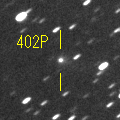
|
It brightened up to 15.3 mag in last winter (Jan. 12, 2022, Hidenori Nohara). Now it is 17.4 mag (Apr. 17, Masayoshi Yoshimi). It stays 18 mag for a while. In the Northern Hemisphere, it will be getting lower gradually. It locates somewhat low in the Southern Hemisphere.
Date(TT) R.A. (2000) Decl. Delta r Elong. m1 Best Time(A, h)
Apr. 29 9 52.11 31 6.1 4.510 4.802 100 17.8 20:16 ( 73, 79)
May 6 9 53.98 30 53.3 4.633 4.823 94 17.9 20:24 ( 83, 72)
|
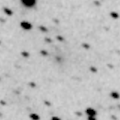
|
Now it is 17.2 mag (Apr. 17, Ken-ichi Kadota). Fading slowly. It will be fainter than 18 mag in May. In the Northern Hemisphere, it stays observable in good condition.
Date(TT) R.A. (2000) Decl. Delta r Elong. m1 Best Time(A, h)
Apr. 29 21 48.68 8 29.8 2.320 2.143 67 17.8 3:39 (283, 33)
May 6 21 56.75 10 49.7 2.293 2.185 71 17.9 3:30 (283, 36)
|

|
It is expected to brighten up to 7.5 mag in October, and it will be observable in excellent condition. Now it is 19.9 mag (Apr. 19, F. Kugel, J. Nicolas). It will brighten rapidly after this. It stays observable in good condition. In the Southern Hemisphere, it becomes low temporarily around the high light.
Date(TT) R.A. (2000) Decl. Delta r Elong. m1 Best Time(A, h)
Apr. 29 21 14.46 -2 8.3 2.238 2.256 78 18.1 3:39 (300, 32)
May 6 21 25.22 -0 36.9 2.103 2.197 81 17.8 3:30 (300, 35)
|
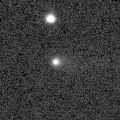
|
Now it is 17.2 mag (Apr. 13, Masayoshi Yoshimi). It will fade out rapidly after this. It will be fainter than 18 mag in May. It stays observable in good condition.
Date(TT) R.A. (2000) Decl. Delta r Elong. m1 Best Time(A, h)
Apr. 29 13 20.23 21 10.7 0.680 1.596 141 17.9 22:52 ( 0, 76)
May 6 13 19.78 18 47.6 0.746 1.643 138 18.2 22:24 ( 0, 73)
|

|
It was predicted to brighten up to 16 mag in 2023. But actually, it is very faint as 18.1 mag (Mar. 29, ATLAS Chile). It stays 18 mag for a while. In the Northern Hemisphere, it is not observable now. In the Southern Hemisphere, it stays observable in good condition.
Date(TT) R.A. (2000) Decl. Delta r Elong. m1 Best Time(A, h)
Apr. 29 20 52.80 -76 8.7 2.965 3.324 102 18.0 3:39 (350,-24)
May 6 21 1.58 -76 27.7 2.930 3.339 105 18.1 3:30 (350,-24)
|
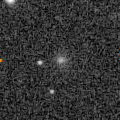
|
It moves along an almost circular orbit. It brightened up to 16.2 mag temporarily in outburst (Jan. 27, Toshihiko Ikemura, Hirohisa Sato). Now it is 17.4 mag (Apr. 10, Michael Jager). Fading slowly. In the Northern Hemisphere, it stays observable in good condition. It locates somewhat low in the Southern Hemisphere.
Date(TT) R.A. (2000) Decl. Delta r Elong. m1 Best Time(A, h)
Apr. 29 10 35.15 25 42.9 5.697 6.141 111 18.2 20:16 ( 11, 80)
May 6 10 35.12 25 26.4 5.797 6.141 105 18.4 20:24 ( 47, 76)
|
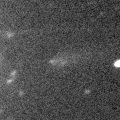
|
Now it is 19.2 mag (Apr. 13, A. Diepvens). Fading slowly. In the Northern Hemisphere, it will be getting lower gradually. In the Southern Hemisphere, it stays observable in good condition. Francois Kugel reported it seems fragmented.
Date(TT) R.A. (2000) Decl. Delta r Elong. m1 Best Time(A, h)
Apr. 29 10 6.57 16 18.4 3.730 4.178 109 18.6 20:16 ( 26, 69)
May 6 10 8.46 16 7.0 3.827 4.179 103 18.7 20:24 ( 44, 65)
|

|
In its last apparition in 2014, it was re-observed after 36-year blank. It has not been observed yet in this apparition. It will turn to fade out rapidly after brightening. It will be unobservable in July.
Date(TT) R.A. (2000) Decl. Delta r Elong. m1 Best Time(A, h)
Apr. 29 23 27.47 -12 46.1 1.434 1.122 51 19.4 3:39 (286, 0)
May 6 0 0.77 -8 40.9 1.386 1.045 48 18.7 3:30 (280, 0)
|
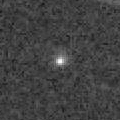
|
It was observed at 17 mag in 2022 autumn. It was predicted to be observable at 17 mag also in 2023 spring. But actually, it is extremely faint as 19.7 mag (Apr. 1, Taras Prystavski). It will fade out rapidly after this. It stays observable in good condition.
Date(TT) R.A. (2000) Decl. Delta r Elong. m1 Best Time(A, h)
Apr. 29 19 10.56 16 43.6 1.511 1.990 102 19.6 3:39 (317, 66)
May 6 18 42.15 19 38.2 1.428 2.040 112 19.6 3:30 (342, 74)
|

|
In the last apparition, it had faded before the perihelion passage. It was expected to brighten up to 17 mag if it would become as bright as its last apparition. But actually, it is extremely faint as 22 mag (Apr. 8, Giuseppe Pappa). It stays 22 mag for a while. It stays observable in good condition.
Date(TT) R.A. (2000) Decl. Delta r Elong. m1 Best Time(A, h)
Apr. 29 13 57.53 7 11.9 1.764 2.722 157 21.6 23:29 ( 0, 62)
May 6 13 53.67 7 28.1 1.777 2.711 152 21.6 22:57 ( 0, 62)
|
|
![]()
 C/2020 S4 ( PanSTARRS )
C/2020 S4 ( PanSTARRS ) 199P/Shoemaker 4
199P/Shoemaker 4 C/2022 E2 ( ATLAS )
C/2022 E2 ( ATLAS ) C/2021 G2 ( ATLAS )
C/2021 G2 ( ATLAS ) C/2022 L2 ( ATLAS )
C/2022 L2 ( ATLAS ) C/2020 R7 ( ATLAS )
C/2020 R7 ( ATLAS ) 117P/Helin-Roman-Alu 1
117P/Helin-Roman-Alu 1 C/2022 W3 ( Leonard )
C/2022 W3 ( Leonard ) C/2023 B2 ( ATLAS )
C/2023 B2 ( ATLAS ) C/2022 P1 ( NEOWISE )
C/2022 P1 ( NEOWISE ) 185P/Petriew
185P/Petriew 118P/Shoemaker-Levy 4
118P/Shoemaker-Levy 4 300P/Catalina
300P/Catalina C/2022 A3 ( Lemmon-ATLAS )
C/2022 A3 ( Lemmon-ATLAS ) 119P/Parker-Hartley
119P/Parker-Hartley C/2023 A3 ( Tsuchinshan-ATLAS )
C/2023 A3 ( Tsuchinshan-ATLAS ) 94P/Russell 4
94P/Russell 4 C/2019 E3 ( ATLAS )
C/2019 E3 ( ATLAS ) C/2022 U2 ( ATLAS )
C/2022 U2 ( ATLAS ) C/2022 U4 ( Bok )
C/2022 U4 ( Bok ) C/2020 F2 ( ATLAS )
C/2020 F2 ( ATLAS ) 96P/Machholz 1
96P/Machholz 1 C/2018 U1 ( Lemmon )
C/2018 U1 ( Lemmon ) C/2021 E3 ( ZTF )
C/2021 E3 ( ZTF ) 116P/Wild 4
116P/Wild 4 C/2022 JK5 ( PanSTARRS )
C/2022 JK5 ( PanSTARRS ) 180P/NEAT
180P/NEAT C/2023 A1 ( Leonard )
C/2023 A1 ( Leonard ) 12P/Pons-Brooks
12P/Pons-Brooks C/2014 UN271 ( Bernardinelli-Bernstein )
C/2014 UN271 ( Bernardinelli-Bernstein ) 99P/Kowal 1
99P/Kowal 1 287P/Christensen
287P/Christensen C/2023 A2 ( SWAN )
C/2023 A2 ( SWAN ) C/2019 O3 ( Palomar )
C/2019 O3 ( Palomar ) C/2020 H6 ( ATLAS )
C/2020 H6 ( ATLAS ) P/2021 N2 ( Fuls )
P/2021 N2 ( Fuls ) 219P/LINEAR
219P/LINEAR 402P/2020 Q3 ( LINEAR )
402P/2020 Q3 ( LINEAR ) 80P/Peters-Hartley
80P/Peters-Hartley 103P/Hartley 2
103P/Hartley 2 263P/Gibbs
263P/Gibbs C/2021 C5 ( PanSTARRS )
C/2021 C5 ( PanSTARRS ) P/2023 B1 ( PanSTARRS )
P/2023 B1 ( PanSTARRS ) 452P/2022 B5 ( Sheppard-Jewitt )
452P/2022 B5 ( Sheppard-Jewitt ) 72P/Denning-Fujikawa
72P/Denning-Fujikawa C/2022 Q2 ( ATLAS )
C/2022 Q2 ( ATLAS ) 280P/Larsen
280P/Larsen![]()




























































